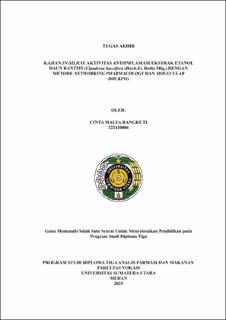| dc.description.abstract | Background: Inflammation is the body's physiological response to infection and
tissue injury. Inflammation also initiates pathogen killing, tissue repair, and helps
restore homeostasis at the site of infection or injury. Acute inflammation is
characterized by swelling/edema, heat, redness, pain, and loss of tissue function as
a result of local immune system, vascular, and inflammatory cell responses to
infection or tissue injury.
Objective: To determine the anti-inflammatory activity of ethanol extract of
rantiti leaves using networking pharmacology and molecular docking methods.
Methods: The method used in this study is a descriptive study using In Silico to
determine the anti-inflammatory effects of Rantiti Leaves (Cipadessa baccifera
(Roxb.Ex Roth) Miq.) using network pharmacology and molecular docking. Tests
carried out include identification of target proteins from bioactive compounds,
Collection of Target Genes for Secondary Metabolite Compounds of Rantiti
Leaves, Collection of Anti-inflammatory Target Genes PPI (Protein Protein
Interaction), Making Cytoscapes, Selection of Protein Codes for Receptor and
Ligand Preparations, Validation of RMSD (Roat Mean Square Deviation),
Receptor and Ligand Docking, Analysis and Visualization of Receptor and Ligand
Interactions.
Results: This study identified four main target proteins, namely Protein IL 1 B
(Interleukin-1 beta), IL 6 (Interleukin-6), SRC (Proto-oncogene tyrosine-protein
kinase Src), and TNF (Tumor Necrosis Factor). Molecular docking experiments
showed that ten main compounds, namely Aucubin acid, Bracteatin, Communesin
H, Galactaric acid, Lynestrenol, Secologanin, Solanidine, Quercetin, Quercitrin,
and Zinnimidine have good affinity to 5R8O, 1ALU, 2H8H, and 3VHE. These
viii
results indicate that rantiti leaves have the potential as herbal therapy in the
treatment of inflammation by modulating various molecular signaling pathways.
Conclusion: Based on the results of the study, the ethanol extract of rantiti leaves
shows potential as a natural anti-inflammatory agent. This is supported by the
results of molecular docking which show that the phytochemical compounds in it
are able to interact well, through hydrogen and hydrophobic bonds, with proteins
involved in the inflammatory pathway and immune system such as IL 1 B, IL 6,
SRC, and TNF. These interactions indicate the ability of the compound to act as a
biological inhibitor of the inflammation process. Thus, rantiti leaves have the
prospect of being further developed as an anti-inflammatory drug, although in
vitro, in vivo tests, as well as pharmacodynamic and toxicity analysis are still
needed to ensure their effectiveness and safety. | en_US |


